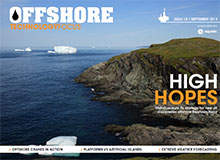
The offshore oil and gas industry has become an increasingly important market for helicopter sales. As manufacturers begin to seek detailed input from the industry for new helicopter designs, we find out what makes the perfect offshore people-carrier.
In the latest issue of Offshore Technology Focus we also ask Statoil about its exploration strategy for previously unexplored prospects found offshore Newfoundland, take a look at one of the world’s biggest offshore slewing cranes, and find out how new weather prediction research could help mitigate risks caused by natural disasters along the US coast.
In an industry first, the Upper Zakum field offshore Abu Dhabi will be operated from a network of artificial islands instead of a traditional platform. We investigate how this shift could facilitate the drilling of oil without increasing production costs.
Moreover, we also look at how Maersk’s Gryphon FPSO has recovered after suffering severe weather damage last year, profile the first fully comprehensive national oil and gas skills survey, and take a look at industry projects Clipper South gas field in the North Sea and Heidrun field in Norway.
Click here to read your free copy.
How well do you really know your competitors?
Access the most comprehensive Company Profiles on the market, powered by GlobalData. Save hours of research. Gain competitive edge.

Thank you!
Your download email will arrive shortly
Not ready to buy yet? Download a free sample
We are confident about the unique quality of our Company Profiles. However, we want you to make the most beneficial decision for your business, so we offer a free sample that you can download by submitting the below form
By GlobalDataIn this issue
The Leasing Boom
An increase in investment has led to a boom in helicopter leasing for personnel transfers. Offshore Technology Focus talks to Gazprom and Samantha White of Air Charter Service about safety, finances and technology.
Click here to read more.
Statoil’s High Hope for Canada
The previously unexplored Harpoon Prospect offshore of Newfoundland, Canada, was a risk for Statoil. We ask Statoil’s senior vice president for North America, Erik Finnstrom, about the company’s strategy and success.
Click here to read more.
Cranes in Action
Heavy Lifting cranes are integral to offshore construction, and they don’t come much bigger than the Liebherr MTC 78000. We look at one of the world’s biggest offshore slewing cranes in action.
Click here to read more.
Platforms vs Islands
Zakum Development Company is using a network of artificial islands instead of a traditional steel rig offshore of Abu Dhabi. We consider the benefits of this unusual solution.
Click here to read more.
Disaster Watch
Hurricanes and tropical storms endanger offshore workers and threaten a vital element of the world’s oil and gas infrastructure. Offshore Technology Focus asks Wilkens Weather Technologies’ Mark Walquist about forecasting.
Click here to read more.
The Gryphon Returns
After suffering severe weather damage two years ago, Maersk’s Gryphon FPSO, one of the North Sea’s most valued assets, is back in production.
Click here to read more.
A National Skills Strategy
Oil and gas skills body OPITO is leading the first fully comprehensive national oil and gas skills survey, in partnership with key stakeholders. We ask managing director Larraine Boorman about the programme.
Click here to read more.
Clipper South Gas Field, North Sea, UK
Clipper South gas field lies in the southern North Sea blocks 48/19 and 48/20 in the UK Continental Shelf (UKCS), about 100km east of the Lincolnshire coast.
Click here to read more.
Heidrun Field, Norway
The Heidrun oil and gas field is located 190km offshore in the Haltenbanken region of the Norwegian Sea in water depths of around 350m.
Click here to read more.
Next issue preview
With millions spent bringing complex wells on-stream, every offshore project brings with it an element of risk. We explore the meticulous risk management process that goes into planning and executing new offshore projects.
We also look at the factors that cause crude oil price swings, learn about the movement to recruit former military personnel into the offshore sector, find out about the ‘sand injections’ that could provide a new source of oil and investigate how the industry is predicting sea ice.
After 25 years, the memory of the Piper Alpha disaster still looms in the industry. To remember one of the worst oil rig disasters, we take a look back through the years, charting the improvements in safety achieved since the fateful incident in 1988.
Sign up for your free subscription to get each future issue delivered directly to your inbox.
Digital Magazine FAQ
The digital magazine is viewable on any computer with Flash Player installed. It is also viewable on mobile devices, iPhones and iPads, although some features and videos may be disabled.




